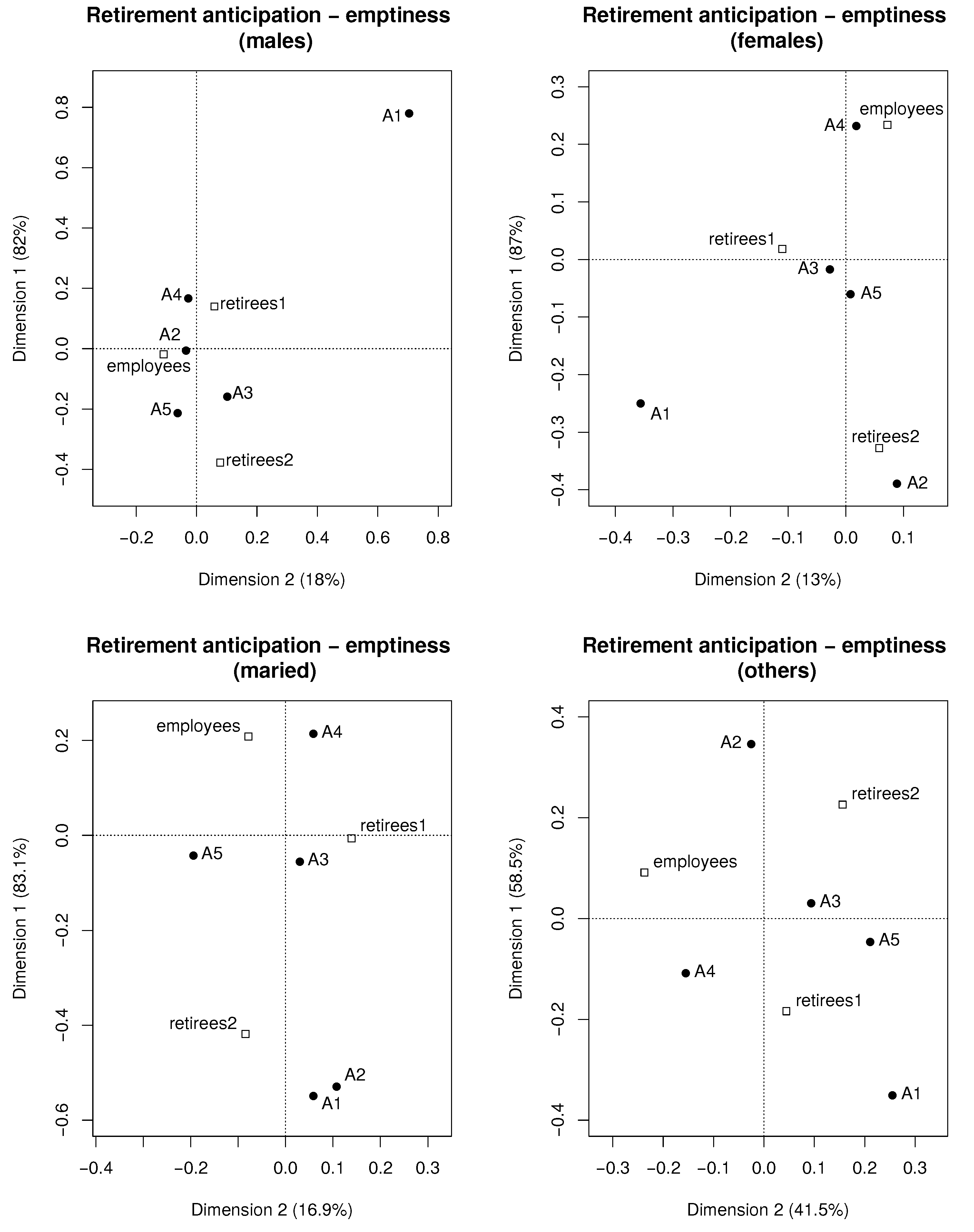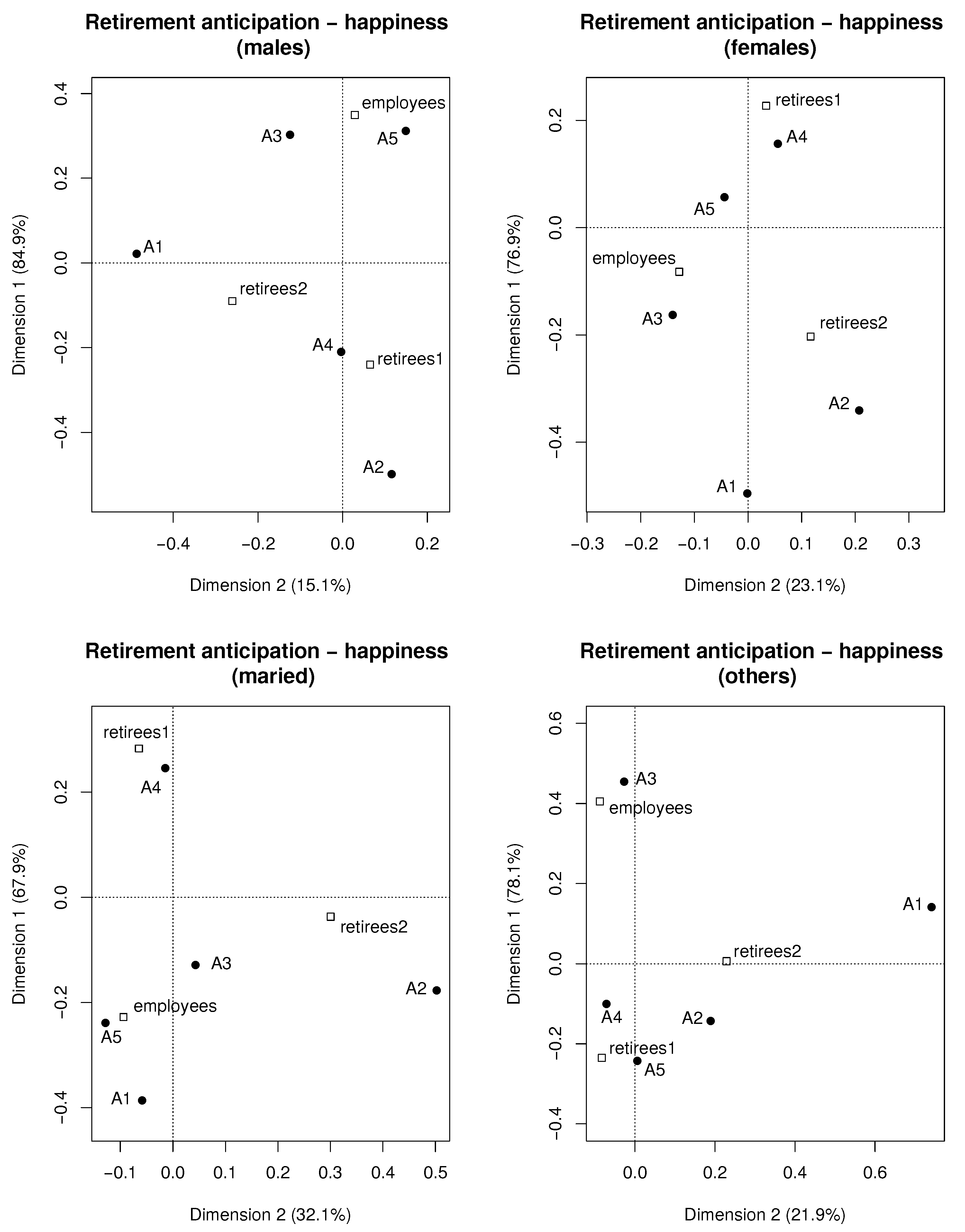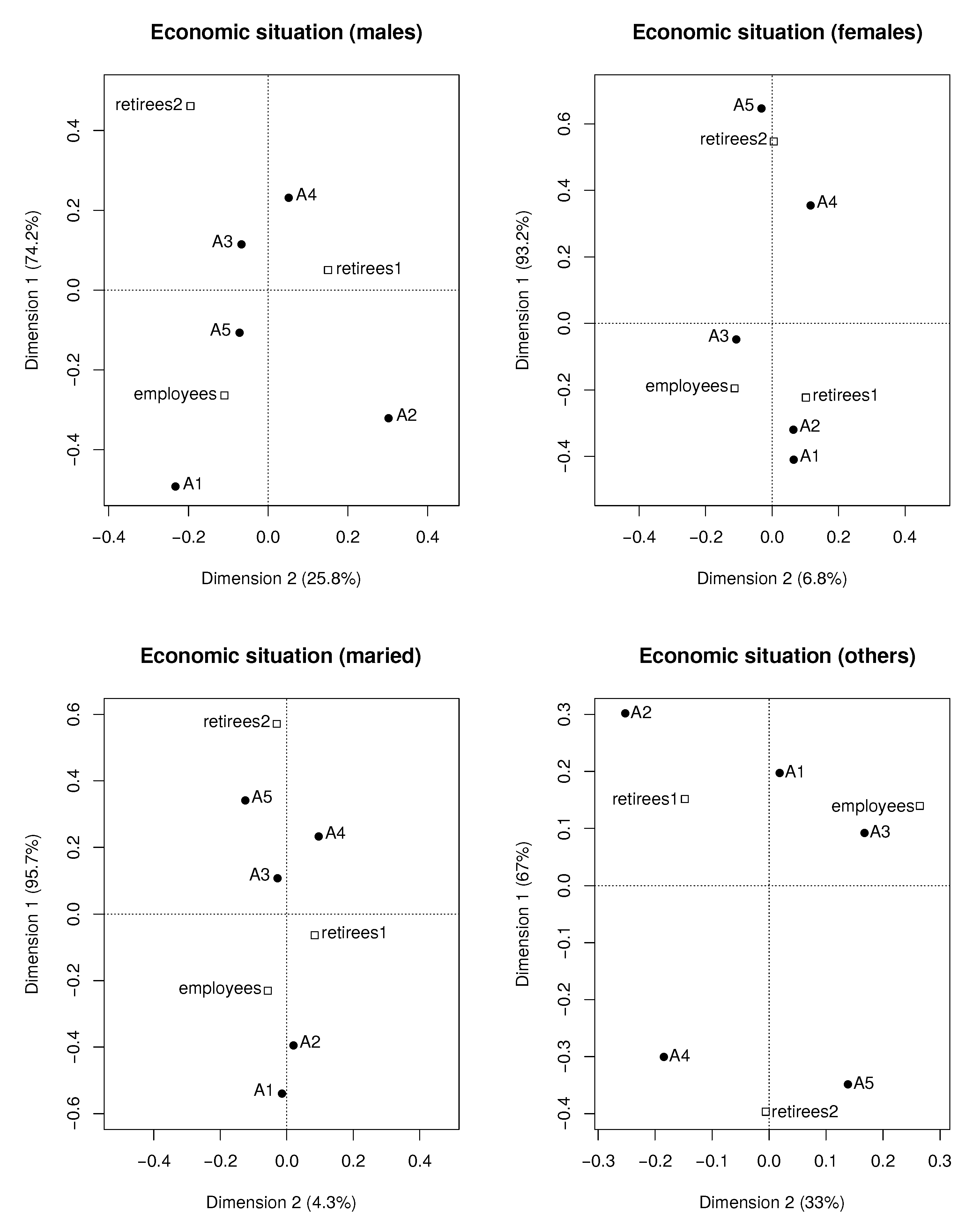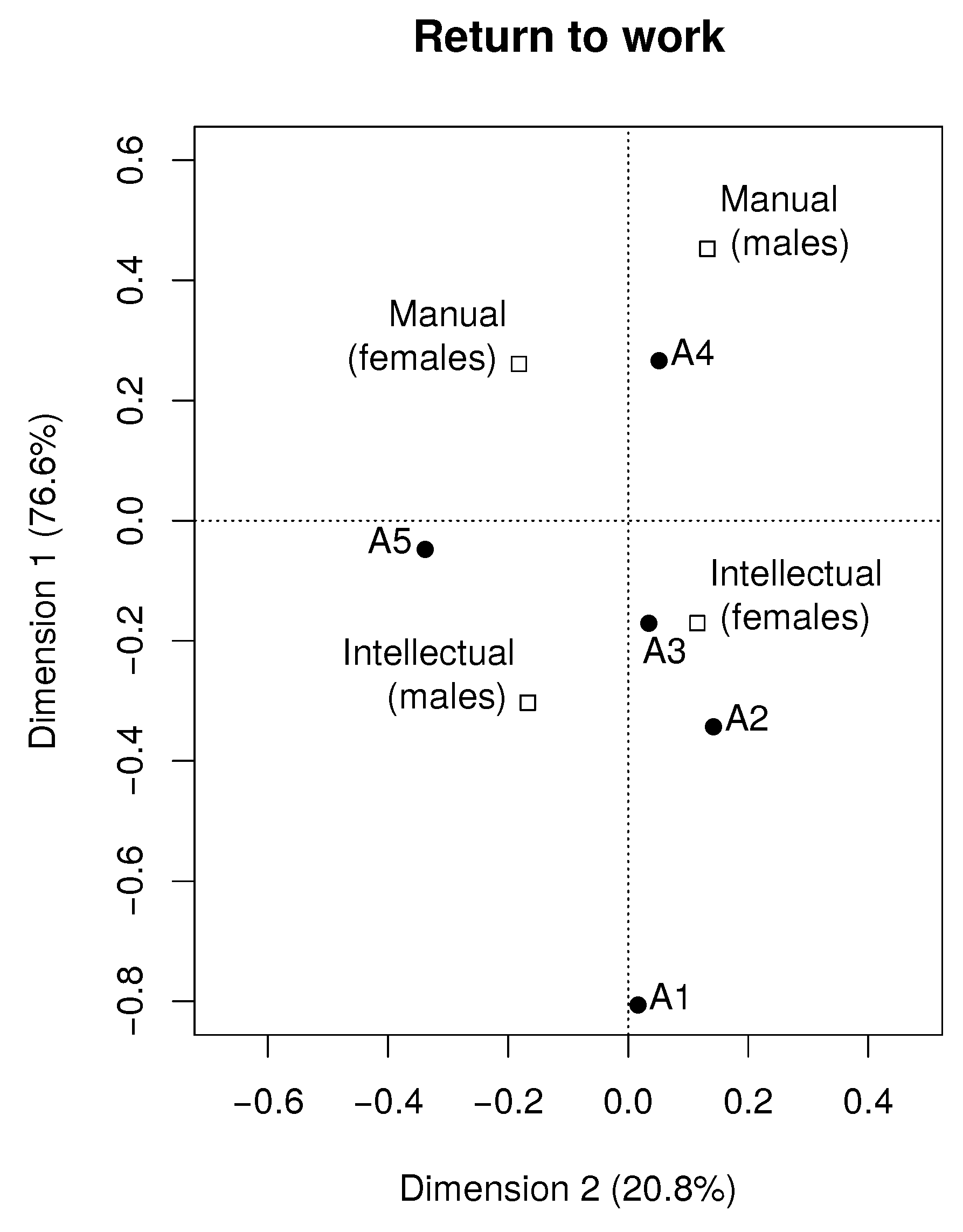1. Introduction
Classification studies are a valuable source of information in various areas of science. The problem of classification is related to the problem of similarity of objects. Objects arranged in simple, one-dimensional sets may be classified in a unique way according to one, properly chosen, aspect of similarity. The problem becomes more complicated if we consider multidimensional sets, i.e., objects characterized by several different aspects. The degree of similarity depends on the selected aspects, on the number of aspects considered and on the mathematical measure establishing the relations between different properties.
One of class of objects considered by us is biological sequences. Both graphical and numerical classification of these objects is possible using methods based on
Graphical Representations [
1,
2]. Within these methods, one can create a large number of different types of numerical characteristics (descriptors) of the plots representing the sequences. One kind of descriptors we propose are the distribution moments related to different statistical distributions describing the DNA sequences. We have shown that using these descriptors a pair of the sequences that differ by only one base can be distinguished. The coordinates of the descriptors representing these sequences are different in the classification maps [
1]. The distribution moments we have also introduced as new descriptors of another class of objects—the molecular spectra [
3,
4]. The applications of the theory of molecular similarity are broad. Except for the studies of the properties of the systems explicitly considered in our works, the new descriptors may have broad range of interdisciplinary applications. For example, they may be applied in computational pharmacology and toxicology [
5]. Our new descriptors have also found their application in the classification of the solutions in the chaotic systems [
6], or in the classification of the stellar spectra [
7,
8]. Another kind of descriptor we propose are values used in the classical dynamics such as coordinates of center of mass or the moments of inertia. Examples of the classification studies using these descriptors may be found in the theory of molecular similarity [
9] or in bioinformatics [
10].
A class of objects considered in this work are groups of individuals. The studies are focused on the
retirement threshold. A graphical representation of the results known as the
Correspondence Analysis (CA) proves to be very useful in this kind of study [
11]. Recently, CA was applied for studies on a variety of problems, for example, on high school dropouts [
12], and also in archeology [
13], in food science [
14], etc. In the CA the information about the whole system is stored on maps in which objects under consideration are represented by points located in a specific way. The classification of the objects is here performed by studying distances between the points and, in particular, by identifying clusters of the points. Objects corresponding to the points which form a cluster are similar in some way.
Progress of medicine and lower fertility rate caused significant changes in the structure of modern societies. The number of seniors in developed countries is growing dynamically. In Poland in 2010 the percentage of people aged 65 and over was 19%. According to Eurostat forecasts, in 2030 the ratio of elderly people to the population aged 15–64 will be 36%, and in 2050—56% [
15].
Due to acceleration of aging process, it seems reasonable to study the quality of life of older people. An important role in shaping the quality of life of seniors plays the retirement threshold, which is described in literature as symbolic moment—starting a new chapter in life. It involves many negative changes such as loss of professional status, deterioration of the economic situation, as well as reduction in the number of social interactions. On the other hand, pensioners have much free time for family life and hobby. Therefore, despite losing one of the most important roles in life, one can set new goals and develop non-professional passions. The change of social role from employee to retiree is a natural process, but such a big change in life may lead to negative psychological effects [
16,
17,
18,
19]. Changes in different aspects of life due to the retirement threshold have been studied in many countries. For example, changes in the sleep duration were studied in the United States [
20] and Finland [
21]; changes in the physical activity were studied in Canada [
22], Belgium [
23], and Finland [
24,
25,
26]; and changes in the body mass index were studied in the United States [
27] and Finland [
28]. A variety of changes in the quality of life in different domains have been observed, for example, in the subjective wellbeing [
29], in the use of time, activity patterns, in health and wellbeing [
30], in the health-related quality of life [
31], in the enjoyment of everyday activities [
32], and in mobility [
33]. The observed changes at the retirement threshold are not unique. Different factors, e.g., sex, social background, and education level, may determine whether they are positive or negative. Education is one of the most important factors determining worry-free retirement [
34]. Recently, the Universities of the Third Age (U3A) became popular in many countries, and their positive influence has been broadly discussed [
35,
36,
37,
38,
39]. The International Association of Universities of the Third Age (AU3A) is a global international organization. The AU3A network includes institutions from Asia, both Americas, Europe, and Australia. The attendance of U3A grows exponentially in the global scale. In China alone the number of universities for senior citizens has grown from 19,000 in 2002 to 70,000 in 2017. The corresponding numbers of students of U3A in China is even more impressive: from 1.8 million to 8 million.
In the present work, we study the influence of factors, such as gender, kind of work, marital status, intellectual activity related to the attendance the University of the Third Age, economic situation, on the expectations and on the worries related to the retirement threshold from the Polish perspective. Some pilot studies on the changes of the quality of life related to the retirement threshold using the World Health Organization Quality of Life-BREF (WHOQOL-BREF) questionnaire, and this graphical representation of the results we have already published [
40,
41,
42,
43,
44,
45]. The WHOQOL-BREF questionnaire is a standard tool in the quality of life research and many versions of this questionnaire have been created in different countries, for example, the Polish version [
46], the Bangla version [
47], the Spanish version [
48], or the Finnish version [
49]. This questionnaire is composed of 26 questions. Two questions are related to
Overall Quality of Life and General Health. The remaining 24 questions concern four domains:
Physical Health,
Psychological,
Social Relationships, and
Environment. Using this questionnaire, we have shown that CA classification maps are a convenient tool for the studies on the role of different factors in changing the quality of life after the retirement threshold, such as gender [
42] and marital status [
43] in four domains, job position in
Physical Health and
Psychological domains [
44], or in
Social Relationships and
Environment domains [
45]. In most of cases, these factors play an important role. The considered factors are particularly important in the
Psychological and in the
Social Relationships domains. The influence of different factors, such as age, education, marital status, and job position on the
Overall Quality of Life and General Health has also been studied by us using this graphical approach and WHOQOL-BREF questionnaire [
40,
41].
2. Materials and Methods
In the present work, the points forming clusters in CA maps correspond to subgroups of all individuals and to their answers to the questions. We used two our own questionnaires:
Questionnaire for an Employed or a Self-Employed Person and
Questionnaire for a Retiree (see
Appendix A).
The studies have been performed in the period from February 2017 to May 2017 in Bydgoszcz, the eighth largest city in Poland (~350,000 inhabitants). We considered 449 individuals (older than 50): 160 employees (100 females and 60 males) and 289 retirees (186 females and 103 males).
We split the group of the retirees to two subgroups: students of U3A denoted in the figures as
retirees2 and non-students of U3A denoted as
retirees1 (
Appendix A, question No. 9R). We also split all the subgroups (
employees, retirees1, retirees2) according to the marital status. We consider two subgroups:
married and
others (
Appendix A, question No. 7ER). In subgroup
others are those individuals who are single, separated, divorced, or widowed.
Groups of individuals and their answers to particular questions (e.g., answer No. 1: A1) are represented by points in the classification maps. In this way, we can classify different subgroups, i.e., we can find subgroups of these individuals who answer in a similar way to some specific questions considered in the questionnaires.
The clusters of points are defined by the angles between vectors and the lengths of these vectors. The initial points of all vectors are located at the central point (CP) of the map, i.e., at the crossing point of the dotted lines marked in the maps. The terminal points of the vectors are denoted in the figures by empty squares (groups of individuals) and by full circles (answers). The squares and the circles belong to one cluster if the angles between the vectors (CP-square and CP-circle) are small. The longer are the vectors, the stronger is the positive association. Angles close to 90 degrees indicate no relationship. It the angles are close to 180 degrees, then they indicate a negative association. The longer are the vectors, the stronger is the negative association.
The final results have been generated using the
R statistics language [
50].
3. Results and Discussion
Figure 1 shows maps related to the answers to questions about emptiness after the retirement (
Appendix A, questions No. 21E and 18R). The structure of the maps for
males and for
females (top panels) are different. For
females (top right panel), the angles between the vectors CP-
employees and CP-
A4, between CP-
retirees2 and CP-
A2 are small. Consequently, we can extract two clusters:
employees—A4,
retirees2—A2.
The lengths of all of the vectors CP-employees, CP-A4, CP-retirees2, and CP-A2 are large. Then, the two associations are strong.
For males (top left panel), the angles are nearly 180 degrees between vectors CP-retirees2 and CP-A4, between CP-retirees1 and CP-A5. Therefore, in this case, we have negative associations:
retirees2—A4,
retirees1—A5.
If the spread between the number of answers to different questions is large then the least common answers usually correspond to the negative associations. The least common answer about emptiness after retirement given by retirees2 is A4 “I was not afraid”. The least common answer about emptiness after retirement given by retirees1 is A5 “I was not afraid at all”. Depending on the lengths of the corresponding vectors, the strengths of the association may vary. In this case, the negative association for males is weak since the lengths of these vectors are smaller than for females. The point representing employees (males) is located close to the central point, so there are no strong associations of this group with any of the answers, while the most frequent answer for the employees (females) is A4 “I am not afraid” (cluster employees—A4).
Transition to retirement is a key moment when an individual must redefine his or her social roles, which is not always successful. Women more often define their social role as a family member: housewife and mother. After the end of their professional activity they find themselves in the role of grandmothers, participating in the family life of their children [
51]. According to opinion polls in Polish society men are less involved in family life and performing household duties so after they terminate professional life they would stay without any activities and many of them may feel emptiness [
52].
If we consider the marital status, we observe negative associations for
married (
Figure 1, bottom left panel):
employees—A1,
employees—A2,
retirees2—A4,
retirees1—A5.
The angles between the vectors CP-employees and CP-A1, between CP-employees and CP-A2, between CP-retirees2 and CP-A4, and between CP-retirees1 and CP-A5 are close to 180 degrees. The least common answers for employees (married) about emptiness after the retirement are A1 “Yes, I am very much afraid” and A2 “Yes, I am slightly afraid”. The least common answer to this question of retirees2 (married) is A4 “I was not afraid”. The least common answer to this question of retirees1 (married) is A5 “I was not afraid at all”. As the lengths of CP-A5 and CP-retirees1 are smaller comparing to other vectors, the association for retirees1 is the weakest.
For
others (
Figure 1, bottom right panel), the structure of the map is different than for
married. We observe different negative associations:
employees—A5,
retirees2—A4,
retirees1—A2.
Analogously, as for married, the least common answer to this question of retirees2 (others) is A4 “I was not afraid”. The marital status is not an important factor determining the kind of answer to this question for retirees2. For retirees1 (others) the least common answer is A2, whereas for married is A5. For employees (others) the least common answer is A5, whereas for employees (married) the least common answers are A1 and A2. For employees and retirees1, the marital status changes the results of the classification.
Similar studies can be performed for other aspects, for example, satisfaction with retirement (
Appendix A, questions No. 15E and 15R). The results are shown in
Figure 2:
males (
Figure 2, top left panel),
females (
Figure 2, top right panel),
married (
Figure 2, bottom left panel), and
others (
Figure 2, bottom right panel). The answer A1 corresponds to “Very unhappy”, whereas A5 corresponds to “Very happy”. We observe different clusters for
males and
females, so gender is an important factor influencing the kind of answer to this question. In particular, for
males we observe the following clusters:
retirees1—A2,
employees—A5.
For females the clusters are:
retirees1—A4,
retirees2—A2.
The most frequent answer of females attending the U3A (retirees2) is the same as retirees1 (males), i.e., A2. There are also several negative associations for males:
employees—A4,
retirees1—A3.
The least common answer for retirees1 (males) is A3. For females the negative associations are:
retirees2—A5,
retirees1—A1.
The least common answer for retirees1 (females) is A1. A5 is located close to the central point so the association for retirees2 (females) is weak.
If we consider the marital status, for this question, we also observe different clusters for
married and for
others. The marital status is an important factor influencing the results of the classification in this case. In particular, for
married we observe the clusters (
Figure 2, bottom left panel):
employees—A5,
retirees1—A4,
and for
others (
Figure 2, bottom right panel)
employees—A3,
retirees1—A5,
retirees2—A1.
The associations retirees1—A5 and retirees2—A1 are weak for others. The most frequent answer for employees (married) is A5 “Very happy”, while for employees (others) the least common answer is A5 (negative association).
Figure 3 is concerned about the question on the adequate amount of money after retirement (
Appendix A, questions No. 19E and 20R). Analogously to
Figure 1 and
Figure 2, the top panels refer to
males and to
females and the bottom ones to
married and to
others. A1 corresponds to the answer “Not at all”, and A5 to “Quite enough”. For
males (top left panel) the clusters are the following:
employees—A5,
retirees2—A3,
and for
females (
Figure 3, top right panel)
retirees1—A1,
retirees1—A2,
retirees2—A5.
The negative associations for males are:
employees—A4,
retirees2—A2,
and for females
employees—A4,
retirees2—A1,
retirees1—A5.
Employees and retirees estimate in a different way the economic situation during the retirement. Some differences are also between males and females. Considering the marital status, the clusters are also different. In particular, the group employees (married) clusters with A1, whereas employees (others) clusters with A3.
The summary is contained in the question about the return to the professional work (
Appendix A, question No. 25R). The results are shown in
Figure 4. The groups are split according to the kind of work—
Manual labor and
Intellectual labor (
Appendix A, question No. 4ER)—and according to the gender. Finally, four subgroups are considered and denoted in the figure as
Manual (females),
Manual (males),
Intellectual (females), and
Intellectual (males). The answer A1 is “Yes, full-time”, and the answer A5 is “Absolutely not”. We observe the cluster
The negative associations are as follows:
Manual (females)—A2,
Manual (males)—A1,
Intellectual (males)—A4.
The most frequent answer of Manual (males) is A4 “No”. The associations of Intellectual (females) with A3 and A2 are weak. None of the groups clusters with A1 “Yes, full-time”. Our analysis shows that in Poland in 2017, reaching the retirement threshold is rather a positive experience.
In line with social expectations, the retirement age was reduced to 60 for females and 65 for males in October 2017.








